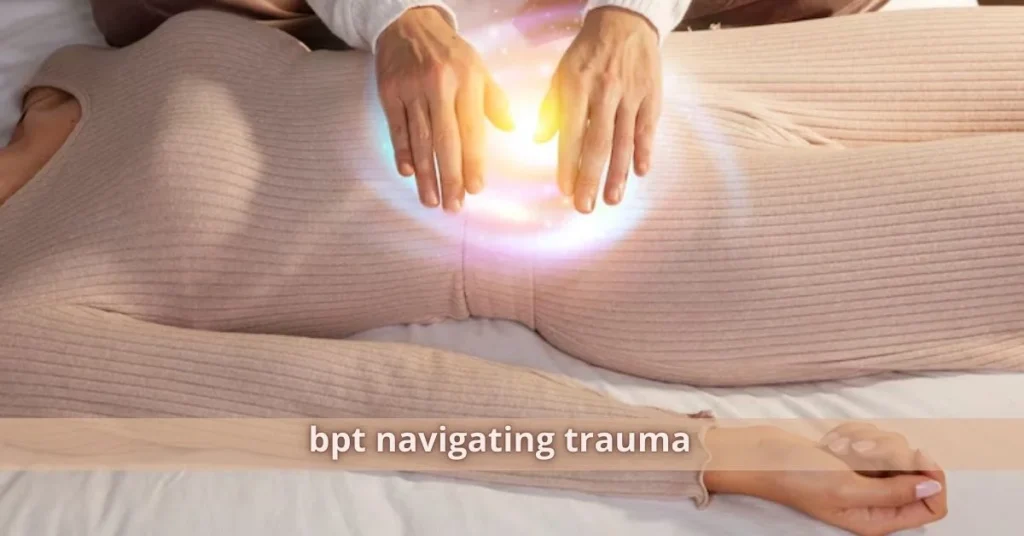Trauma can leave profound marks on our lives, often shaping how we think, feel, and interact with the world. While many may associate trauma with emotional pain, its reach extends far beyond the mind. As we journey through life’s challenges, understanding trauma and its effects is crucial for anyone aiming to heal holistically.
Have you ever experienced a moment that changed everything? A single event or series of events that shook your foundation? You’re not alone. Many people are navigating these turbulent waters without even realizing it. This blog post will take you through a powerful exploration of BPT navigating trauma—a path that embraces whole-body healing.
Join us as we uncover how trauma influences our bodies and minds alike. We’ll also discuss traditional treatment methods and shine a light on innovative approaches that prioritize holistic well-being. Whether you’re seeking personal insight or looking to support someone else in their healing journey, this guide offers valuable tools and perspectives to help navigate the complexities of trauma effectively.
Understanding Trauma and its Effects
Trauma is a deeply personal experience. It can stem from various sources, such as accidents, natural disasters, loss, or abuse. Each person’s reaction to trauma varies widely.
When we talk about trauma, it’s essential to recognize its ripple effects. Emotional distress often manifests through anxiety and depression. But the impact doesn’t stop there; it also seeps into our physical well-being.
Many individuals find themselves grappling with chronic pain or fatigue after experiencing trauma. Sleep disturbances and digestive issues may arise too. The body holds onto these experiences in unexpected ways.
Understanding how trauma affects us helps illuminate the path toward healing. Awareness of its complexities enables survivors to address not just their emotions but also their physiological responses—an important step in reclaiming one’s life and joy.
How Trauma Affects the Body
Trauma leaves a profound mark on the body, often manifesting in unexpected ways. It can disrupt normal functioning, triggering a cascade of physical symptoms.
Many people experience chronic pain, fatigue, or digestive issues after trauma. The body’s stress response becomes hyperactive and stays that way long after the event has passed.
Muscles may tense up as if they are bracing for another impact. This tension can lead to headaches and stiffness, creating a cycle that’s hard to break.
Additionally, trauma affects sleep patterns. Insomnia or restless nights become common struggles, further complicating recovery.
The connection between mind and body is undeniable; emotional distress frequently translates into physical ailments. Awareness of this link is crucial for those navigating their healing journey while addressing both aspects together.
Traditional Approaches to Treating Trauma
Traditional approaches to treating trauma often focus on talk therapy. Many seek help through psychotherapy, where they explore their experiences with trained professionals. This method can provide a safe space for individuals to express their feelings.
Medication is another common avenue. Antidepressants and anti-anxiety medications are frequently prescribed to manage symptoms associated with trauma. While these can offer relief, they often address only the surface issues rather than the root cause.
Cognitive Behavioral Therapy (CBT) stands out as a popular choice in traditional settings. It helps individuals identify negative thought patterns and replace them with healthier ones. This structured approach aims for practical steps toward healing.
Group therapy provides community support. Sharing stories within a group setting allows individuals to realize they’re not alone in their struggles, fostering connection and understanding among peers dealing with similar experiences.
The Benefits of a Whole-Body Healing Approach
A whole-body healing approach offers a comprehensive strategy for navigating trauma. By addressing both physical and emotional aspects, it fosters deeper recovery.
This method recognizes the intricate connection between mind and body. When trauma impacts one area, it often reverberates throughout the entire system. Treating only symptoms can leave underlying issues unresolved.
Engaging in practices like yoga or mindfulness creates harmony within oneself. These techniques help release stored tension while promoting mental clarity.
Moreover, this holistic path encourages self-awareness. Individuals learn to recognize their triggers and responses better, empowering them on their healing journey.
Community plays a crucial role too; support from others enhances resilience. Connecting with those who share similar experiences cultivates understanding and compassion.
Adopting a whole-body perspective paves the way for lasting change, nurturing overall well-being beyond mere survival.
Techniques for Navigating Trauma
Navigating trauma requires a toolbox of effective techniques tailored to individual needs. Mindfulness practices can ground you in the present, reducing anxiety and promoting emotional clarity. Simple breathing exercises are invaluable; they help regulate your nervous system and provide immediate relief from overwhelming feelings.
Movement is another powerful method for processing trauma. Activities like yoga or dance not only foster physical well-being but also encourage emotional expression. Engaging with creative outlets—like art or writing—can facilitate healing by allowing you to articulate experiences that feel too difficult to voice.
Establishing healthy boundaries is essential as well. This helps protect your energy and fosters better relationships, creating a supportive environment for healing. Journaling can be an effective way to track emotions and reflect on progress over time, giving insight into patterns that need attention or change.
Connecting with nature often offers solace and perspective during challenging times, reminding us of life’s inherent beauty amidst chaos.
Self-Care Practices for Trauma Survivors
Self-care is essential for trauma survivors. It helps restore balance and fosters resilience.
Start with mindfulness practices. Deep breathing can ground you in the present moment, reducing anxiety and stress levels. Even a few minutes of meditation each day can make a significant difference.
Physical activity plays a crucial role too. Engaging in exercise releases endorphins, which elevate your mood and boost overall well-being.
Nourishing your body matters as well. A balanced diet rich in whole foods supports mental health and keeps energy levels stable.
Journaling offers an outlet for emotions that might be difficult to express verbally. Writing down thoughts allows for reflection and understanding, bringing clarity to complex feelings.
Don’t underestimate the power of connection. Surround yourself with supportive friends or join groups where shared experiences create bonds that foster healing together.
Seeking Professional Help and Support Systems
Navigating trauma can feel overwhelming, and seeking professional help is a vital step toward healing. Therapists and counselors trained in trauma-informed care provide valuable support. They create safe spaces for you to explore your feelings and experiences.
Support systems play an equally crucial role. Connecting with friends or family who understand can offer comfort during tough times. Sometimes, peer support groups are beneficial too. Sharing stories within a community can foster connection and resilience.
Professional guidance helps individuals develop coping strategies tailored to their needs. It’s not just about talking; it’s about learning how to process emotions effectively while rebuilding trust in oneself.
Finding the right therapist or group may take time but don’t hesitate to seek what resonates with you. Remember, reaching out is a sign of strength—not weakness—and it opens doors to new paths of healing.
Conclusion
Bpt Navigating trauma is a complex journey that requires understanding, patience, and care. It’s essential to recognize how deeply trauma can affect both the mind and body. By embracing a whole-body healing approach, individuals can find more effective ways to cope with their experiences.
Many traditional treatments focus solely on mental health, which may leave physical symptoms unaddressed. A holistic perspective acknowledges the interconnectedness of body and mind. This way, survivors not only work through emotional pain but also alleviate physical manifestations of stress.
Utilizing various techniques—such as mindfulness practices, movement therapies like yoga or dance, and creative outlets—can be incredibly beneficial in navigating trauma. These methods encourage expression and release while promoting self-awareness and grounding.
Self-care remains an indispensable part of recovery for trauma survivors. Simple routines that prioritize rest, nutrition, exercise, and social connections help build resilience over time. Each individual’s path will look different; it’s vital to honor personal preferences during this process.
Seeking professional help should always be considered if feelings become overwhelming or unmanageable. Support systems amplify the healing journey by offering tailored guidance from trained professionals who specialize in BPT navigating trauma.
Healing takes time—it’s not linear—but each step forward is significant on this transformative path toward wholeness.
FAQs
What is “BPT Navigating Trauma”?
“BPT Navigating Trauma” refers to using Body Psychotherapy (BPT) as a holistic method to heal trauma by addressing both emotional and physical symptoms. It integrates movement, breathwork, and somatic awareness to release trauma stored in the body.
How is BPT different from traditional talk therapy?
Unlike traditional talk therapy, which focuses mainly on thoughts and emotions, BPT involves the body—using movement, breath, and sensation to unlock and release trauma stored physically.
Why does trauma affect the body as well as the mind?
Trauma triggers the body’s stress response, often leading to muscle tension, chronic pain, fatigue, and sleep issues. These physical reactions persist because trauma gets “stored” in the nervous system and body tissues.
What are some effective techniques used in BPT for trauma recovery?
Techniques include guided breathwork, body movement, grounding exercises, and somatic tracking. These help regulate the nervous system, improve body awareness, and safely process trauma.
Can BPT help if I’ve already tried talk therapy?
Yes! Many people turn to BPT after finding that talk therapy alone doesn’t fully address their symptoms. BPT complements traditional approaches by engaging the body, often leading to deeper and more lasting healing.






